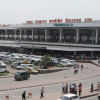With the new HSIA terminal comes greater responsibilities

The fact that a 12-year-old has managed to breach at least five layers of security at Hazrat Shahjalal International Airport (HSIA) comes as no surprise – despite leaving related authorities scrambling to find answers – since security has never been a strength of our airport authorities. One might remember the people passing security with firearms, or a plane being hijacked, albeit with a toy gun.
In 2016, the United Kingdom – for the right reasons – raised concern about the security system at Dhaka airport, and suggested preparing a work plan to ensure a "sustainable security system." The lapses found by a delegation of the UK aviation safety agency were such that the UK even warned of adverse impacts on Dhaka-London flights if the situation did not improve.
And then, on February 24, 2019, the hijacking of a plane unfolded, and red flags were raised about the inadequate security systems at HSIA. It was suggested that since it was a toy gun, the metal detectors did not detect it. But what about the other security checks? State Minister for Civil Aviation and Tourism Mahbub Ali said that the hijacker had crossed all the required security checks at the domestic terminal of the airport, before boarding the Dubai-bound Biman flight. An obvious question, how did he manage to smuggle the toy gun inside the aircraft then? Interestingly, the hijack was attempted the very day the prime minister had visited Chattogram and both the airports were on VVIP high alert.
On March 6 that year, actor Ilias Kanchan managed to pass the first security checkpoint at HSIA before self-declaring that he was carrying a firearm in his laptop case.
Although security interventions have been installed at HSIA – including full body X-ray scanners, explosives detection systems, and dual-view X-ray machines – the recent breach of security by the young boy has once again brought to the fore the loopholes in the entire system. While this boy was not carrying any firearm or explosive, he did not even have a passport. The question remains, how can an individual without a passport board an international flight? What kind of security measures do we have in place that allow for such incidents?
Such an incident occurring weeks before the partial inauguration of the much-awaited third HSIA terminal poses portents for the security management team, and Civil Aviation Authority of Bangladesh (CAAB) in general.
The third terminal is set for partial inauguration on October 7, when 12 of the 26 boarding passages are expected to be operational. The entire terminal is expected to be usable by the end of 2024, and once fully completed, is expected to serve more than 12 million passengers annually. The current annual capacity of the first and second terminals is about 8 million. Given that airport security is struggling to facilitate the existing capacity, the security team needs a significant revamp, and a watertight strategy should be in place post inauguration of the third terminal.
Gold and drug smuggling remains a major headache for Dhaka airport, with news of seizures making regular headlines. Data from the National Board of Revenue suggests that in 2022 alone, more than 52,195 kg of gold, worth Tk 44,366 crore, was smuggled into the country. The authorities should, therefore, have a plan in place to counter a possible rise in such crimes with the new terminal's launch, as more passengers mean higher risk of smugglers taking advantage of said passengers. Unfortunately, in such cases, airline crew and even pilots have been found to be involved, so vigilance has to be even more stringent and all-encompassing.
However, money and resources must not be pilfered to tighten the security system. While new resources and workforce is required to ensure uninterrupted and flawless security, the investment and procurement processes should be optimised and strictly monitored to root out any possibility of corruption.
While so far Biman has been providing ground handling service to domestic and foreign aircrafts, given its shameless legacy of corruption, the authorities might be wiser to choose a different ground handler for the new terminal. Biman has already started suggesting that they are investing in new equipment and manpower (they have purchased new equipment worth Tk 1,000 crore, with another Tk 700 crore investment in the offing). There have been media reports that several local and foreign companies have expressed interest in managing ground handling at the third terminal and that the authorities are considering negotiating a deal with a Japanese company. In such a scenario, the authorities should be transparent in the selection process of the ground handler.
While the new terminal will open new windows of opportunity for the country's civil aviation sector, it will also enhance the risks, including those relating to national security and smuggling. Only a facelift of HSIA will not improve its reputation in the international space. It is the service and security that will speak volumes about the airport's efficiency and trustworthiness.
Tasneem Tayeb is a columnist for The Daily Star. Her X handle is @tasneem_tayeb

 For all latest news, follow The Daily Star's Google News channel.
For all latest news, follow The Daily Star's Google News channel. 









Comments